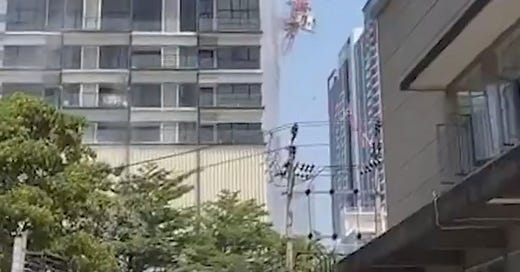A powerful 7.7 magnitude earthquake struck Southeast Asia on Friday, causing widespread destruction and claiming thousands of lives across Myanmar and Thailand. The deadly quake, which hit at midday, had its epicenter near Mandalay, Myanmar’s second-largest city. Buildings crumbled across the region, including a towering under-construction skyscraper in Bangkok, Thailand, and a mosque in Taungoo, Myanmar.
The US Geological Survey issued a red alert, estimating fatalities could range from 1,000 to 10,000, with fears the toll may climb as rescue efforts continue.
In Myanmar, harrowing scenes unfolded as emergency workers retrieved bodies from rubble in Mandalay and surrounding areas. The quake led to the partial collapse of Mandalay’s historic royal palace and damaged highways and bridges in nearby Sagaing. In Taungoo, a mosque’s collapse killed at least three people. A hotel in Aung Ban also fell, resulting in two deaths and injuring at least 20 others. Historic pagodas were destroyed. A strong aftershock measuring 6.4 magnitude exacerbated the devastation.
Thailand also suffered significant casualties and destruction. An under-construction 30-story building in Bangkok collapsed near the Chatuchak market, killing at least eight people and leaving dozens unaccounted for. Dramatic video footage captured the moment the structure fell into a massive cloud of dust as terrified onlookers fled (see above).
Elsewhere in Bangkok, water cascaded from a rooftop pool at a luxury hotel while panicked residents ran onto the streets. The city’s authorities declared Bangkok a disaster-stricken area as rescue teams worked to stabilize collapsed sites and assist victims.
Both countries are grappling with the aftermath of the disaster. In Myanmar, which is already battling a violent civil war, the ruling military declared a state of emergency across multiple regions, though delivering aid to affected areas remains uncertain. Meanwhile, Bangkok’s densely populated greater metropolitan area—home to over 17 million residents—faces logistical challenges in rescuing survivors and assessing damage.
Survivors shared chilling accounts of their experiences during the quake. Witnesses described buildings swaying violently, debris falling from rooftops, and widespread chaos as people fled onto streets in panic. In Bangkok’s shopping malls and bars, tourists recounted moments of terror when the tremors struck, leaving the city’s already congested streets gridlocked with fleeing residents.
How Would California Fare in Comparison?
This disaster underscores the vulnerabilities of Southeast Asia’s densely populated urban centers and their ability to withstand powerful seismic events.
California’s earthquake building codes are significantly stronger than those in Myanmar and Thailand, reflecting the state’s high seismic risk and history of devastating earthquakes. Based on the International Building Code with state-specific amendments, California’s regulations are regularly updated and emphasize life safety, structural integrity, and damage tolerance, often incorporating advanced technologies like base isolation to withstand powerful quakes.
Conversely, Myanmar and Thailand have less robust seismic codes, with enforcement and adherence varying widely; Myanmar’s frameworks, in particular, are limited by economic and technical constraints. While modern buildings in California are designed to endure a 7.7 magnitude earthquake without collapsing, protecting occupants’ lives, structures in Myanmar or Thailand are at far greater risk of severe damage or collapse due to weaker codes and retrofitting efforts.
However, the reality in California is more complex, as many older buildings—such as concrete apartment complexes built in the 1960s—were constructed before modern seismic codes were implemented. These structures often lack adequate reinforcement to withstand the lateral forces generated by a major quake.
Despite efforts to retrofit some older buildings and mandate upgrades for vulnerable structures like “soft-story” apartments, thousands of buildings remain at risk of catastrophic failure during a 7.7 magnitude earthquake. Retrofitting is expensive and time-consuming, leaving many communities vulnerable, particularly in areas like Los Angeles where aging infrastructure is common. While newer buildings might perform well under such extreme conditions, older structures could still collapse, underscoring the need for widespread retrofitting to ensure public safety.
To help earthquake victims, consider donating to Samaritan’s Purse.














Share this post